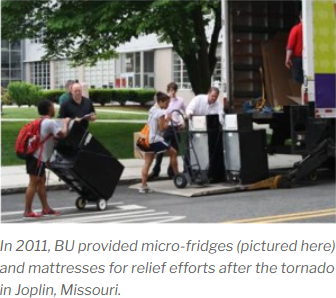Sustainability@BU, February 2014
Every year Boston University makes strides in reducing waste on campus. Since 2006, BU has reduced its total waste by 12% and has increased its recycling rate from 3% to 30%.
Surplus furniture is no exception. BU has an aggressive and successful program to divert what it no longer needs through organizations that ensure good stuff can be reused, and if not, recycled.

BU generates surplus regularly, whether it is classroom furniture from a renovation, a few desks and file cabinets from an administrative office, or a dozen cafeteria tables and chairs. There is always something that needs to find a new home.
This is perfectly good stuff. It’s just no longer needed. The issue is, what to do with it? There are really two options: reuse it on campus or give it away. Since 2008 BU has worked with the Institution Recycling Network (IRN) to donate unwanted furniture to charities throughout the world, diverting more than 886 tons from the landfill.
The other option, reusing surplus on campus, has not really been viable because the University simply does not have the storage space to hold onto items that may be useful down the line. Starting late last year, that’s where Olympia Moving and Storage comes into the picture. Working together, Olympia, IRN and BU have developed an efficient, reliable method to tag, track, retain, and handle surplus so that it can be effectively reused by the University.
Mike Lyons, a senior buyer and BU’s recycling coordinator, saw an opportunity to work with trusted vendors and to save some money. “We were donating furniture that could still be used by other departments here on campus, so I saw a need for a program,” said Lyons.
The system includes an accurate, real-time inventory that allows BU Purchasing and Planning & Design staff to match available surplus with need.
A key to the program is Olympia’s storage capability through their warehouse in Watertown, five miles from BU’s campus. Surplus delivered to the warehouse is bar-coded, photographed, and then uploaded to an online database. Whenever the BU Planning & Design team needs furniture for a project, they can log on and review the available inventory. When they find surplus that matches their needs, they place an online order and the items are retrieved. This cuts down on project costs because the items are already BU property.
Inevitably, some surplus never finds a University user. To keep these items from accumulating dust and storage charges, pieces are date-tagged when they are received for storage. If they are not claimed for reuse on campus after a period of time, they are removed from storage, deleted from the inventory, and delivered to IRN. IRN then loads and ships the surplus for reuse by one of IRN’s charitable partners.
Since coming online in November 2013, the program has been successful, bringing a regular stream of surplus back into use on campus. In a few short months, BU has:

- Diverted 100% of surplus furniture and equipment from disposal;
- Established a program that will eliminate the unnecessary purchase of new furniture and equipment, and eliminate hundreds of dumpster pickups;
- Enhanced efficiencies in the use of storage space;
- Obtained cradle-to-cradle tracking and accountability for the disposition of all useful BU furniture and equipment.
Most importantly, the program helps BU maximize the first two tenets of a well-known adage, “Reduce, Reuse, Recycle.”

